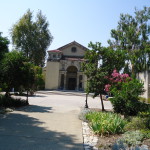The 11th International Congress of Coptic Studies took place at the Claremont Graduate University in California this summer (July 25–30, 2016). Gesa Schenke, our specialist in Coptic and Papyrology, flew out to chair a session on hagiographical texts and to give a paper on a late 4th/ early 5th century papyrus document with a private invocation to martyr saints (P.Mich. inv. 1523).
The paper, entitled It’s in Their Bones. On the Origins of a Coptic Cult of Saints, argued that for an understanding of the practicalities of a working cult of saints, the direct non-literary evidence known as “documentary” evidence, found predominantly in Egypt, cannot be stressed enough. Unaltered by evolving literary, political, or religious agenda and conventions, the Egyptian documentary evidence confronts us with a directness that can only be taken at face value. It is the most reliable primary evidence one could wish for. P.Mich. 1523 is an example of such primary evidence. The papyrus attests the attempt of a woman named Theodora to invoke the intercession of martyrs in her lawsuit against a married couple. Theodora claims to be the injured party and invokes their assistance to ensure the financial destruction of her opponents. ‘May they see your miracles and wonders!’, she implores the martyrs. Such an unmediated witness to a woman seeking the help of saints, asking them to display their power to her advantage, illustrates that the saints, within a hundred or so years of Constantine’s religious revolution, were sought out as powerful allies in Egypt.
Following the Coptic Congress in California, Gesa moved straight on to Barcelona for the 28th International Congress of Papyrology (August 1–6, 2016). There she chaired a session on Christian papyri and presented a paper on a Greek letter of the 7th century sent from a female monastery of Shenoute, which announced the dispatch of a fragment from the garment of its patron saint for the purpose of healing a woman suffering from a daemon (P.Paramone 14). In her contribution, entitled Reconstructing the Origins of the Cult of Saints in Egypt: Documentary Evidence for Healing Miracles, she illustrated that contact relics sent from monasteries were supposed to convey the patron saint’s power to the patient and were expected to have a healing effect on the afflicted, regardless of whether the saint was a famous martyr or a former abbot. The claim to miraculous power was made not just for the relics or contact relics themselves, but for anything associated with the saints, even churches or monasteries that just bore their name.

